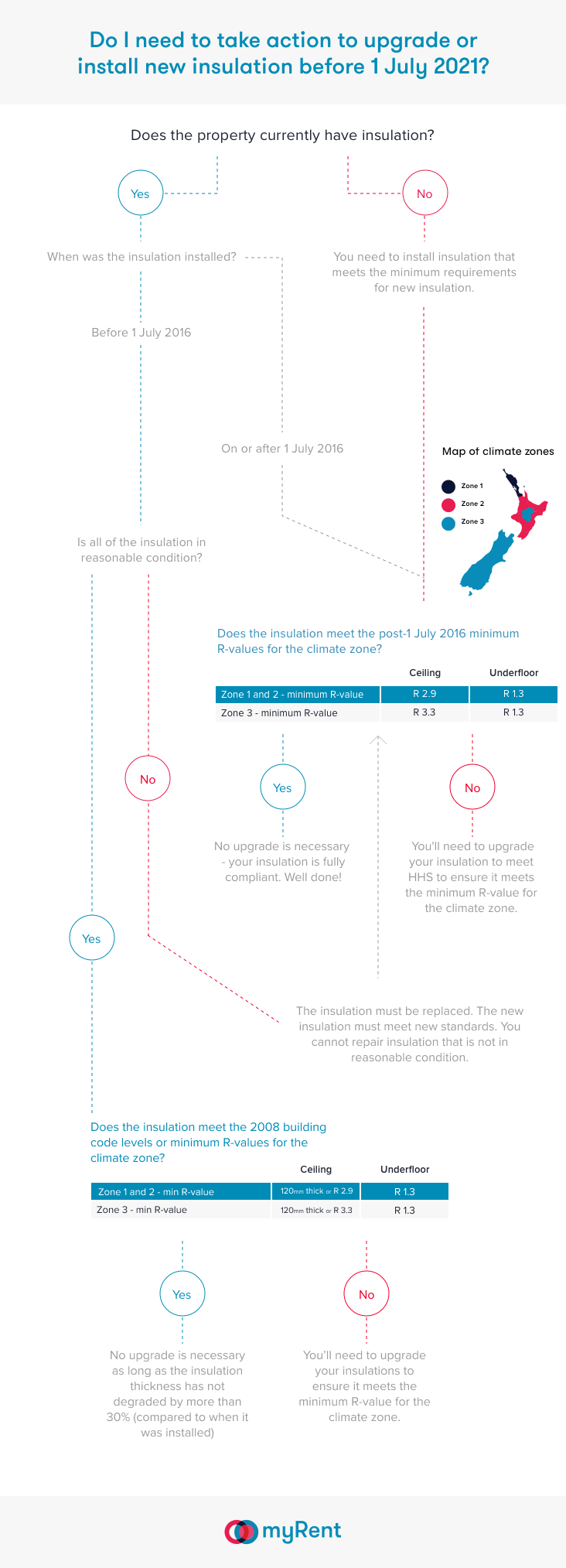A landlord who has installed new insulation since 1 July 2016 should already meet the Healthy Homes insulation standard and probably don't need to do anything further. Just check if the insulation is still in reasonable condition.
But if the insulation was installed before 2016, some homes may require new insulation or a "top-up" to bring it up to the standard.
What is the required level for insulation beginning 1 July 2021? Do I need to upgrade or install new insulation?
Use our flowchart to see whether you need to take action to upgrade or install new insulation.
Pro Tip: If you're unsure whether your insulation meets the requirements, you should consult a qualified, professional insulation installer or inspector.
Note: consider ceiling and underfloor insulation separately. You should go through the flowchart twice: once for ceiling insulation, and then again for underfloor insulation.

Repair or Installation of Foil Insulation is Banned
DANGER WARNING: Foil insulation poses a danger to your safety as it may conduct electricity from live wires. You should turn off mains power at your premises before inspecting foil insulation and/or consult a qualified professional insulation expert.
Due to the danger posed by foil insulation, installation or repair of it is now banned. This means that landlords are now prohibited from:
-
Installing new Foil Insulation - landlords cannot install new foil insulation.
-
Replacing or Repairing Foil Insulation - landlords cannot repair foil insulation that does not meet the new requirements - if the foil insulation is not in reasonable condition and does not have a high enough R-value, then it must not be repaired or replaced with foil insulation. It must be replaced with non-foil insulation.
You may only continue to use foil insulation if it was installed before 1 July 2016 and it is in reasonable condition and meets the R-value requirements.
Wall insulation is not necessary for Healthy Homes Standards compliance.
But under the Act, the landlord should provide information about wall insulation if there is one available.
Exceptions to Insulation Standard:
There are 3 exceptions where a property may be exempt from having to meet the ceiling and underfloor insulation requirements:
1. Underfloor or Ceiling Space Unsafe or Impracticable to Access
This exception applies to areas of homes where it would be unsafe or impracticable to access those areas due to limited access, their design, the potential for substantial damage, or health and safety reasons. The area must be unsafe or impracticable for a professional insulation installer, not just a landlord or other unqualified person.
There are 3 common situations where this exception may apply:
-
Substantial Building Work or Damage Required - When an experienced professional insulation installer could not access the area without causing substantial damage to the property or significant building work being required.
-
Health and Safety Risk - When an experienced professional insulation installer could not install insulation in particular areas without creating a risk to the health and safety of any person. The risk must be greater than that usually considered acceptable for professional installers. This is usually where installation would pose a significant risk to the safety or health of the installer.
-
Installation Impracticable - When it is simply not reasonably practicable to install insulation in a particular area. For example, because there is not sufficient space between the ceiling and the roof.
This exception applies to particular areas of every rental property. So, if it would be unsafe or impracticable to install insulation for one room, insulation must still be installed in all other rooms where it is safe and practicable to do so.
No Exception: When there is no current access point for ceiling or underfloor
Even if there is no existing access point for a ceiling or underfloor, the landlord is expected to create such an access point to conduct the necessary insulation work, provided that it does not require significant building work.
2. Partial exemption for certain underfloor insulation
If the property has existing underfloor insulation that was installed when the home was built or converted. This insulation must still be in reasonable condition. Landlords must have a copy of any compliance documents that show the property met the requirements of the time.
3. Underfloor or Ceiling Spaces which are directly below or above habitable spaces
It will commonly be impracticable to install insulation in areas of ceiling or underfloor which are directly above or below habitable spaces. This might be another floor of the same property or another apartment. These areas do not require insulation to meet the HH insulation standard.
Uninhabited outbuildings (sheds, garages) are exempt. However, if a garage is located directly below habitable spaces, the underside of the floor between the garage and the habitable space needs to be insulated. Habitable outbuildings (e.g. studios, sleepouts) require insulation where it is reasonably practicable to install.
The information contained in this article is exclusively for promotional purposes. It does not in any way constitute legal advice and should not be relied upon as the basis for any legal action or contractual dealings. The information is not and does not attempt to be, a comprehensive account of the relevant law in New Zealand. If you require legal advice, you should seek independent legal counsel. myRent.co.nz does not accept any liability that may arise from the use of this information.


